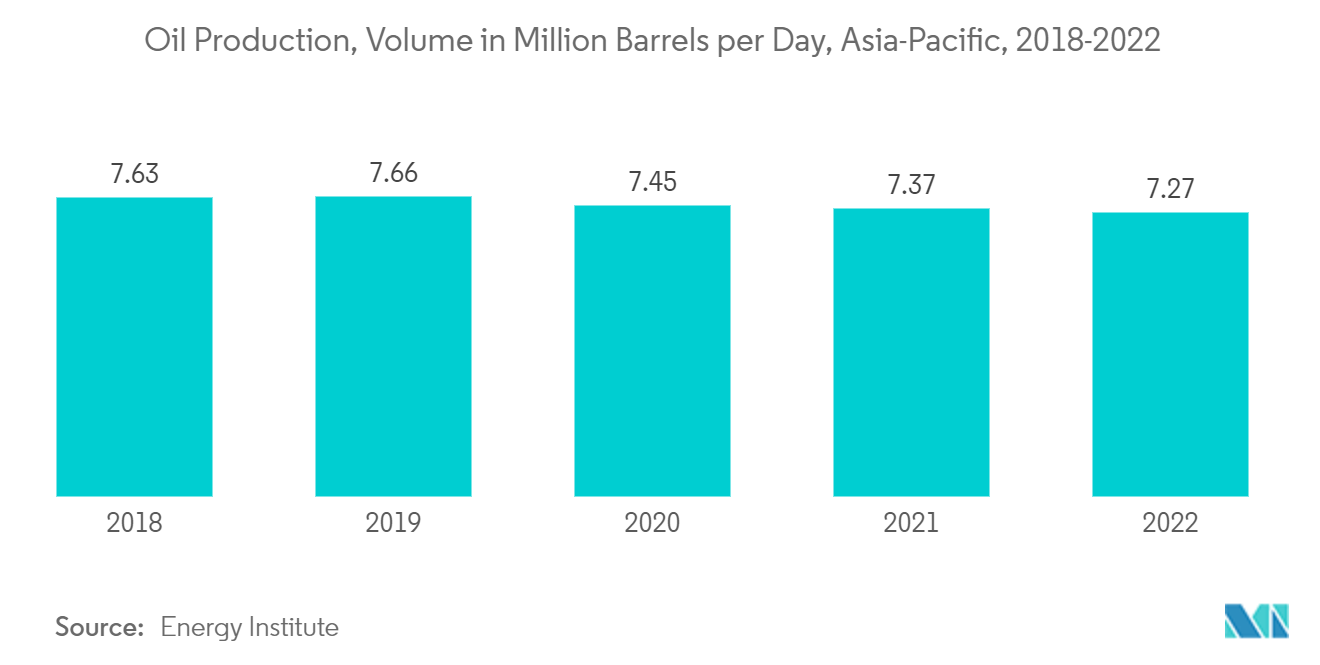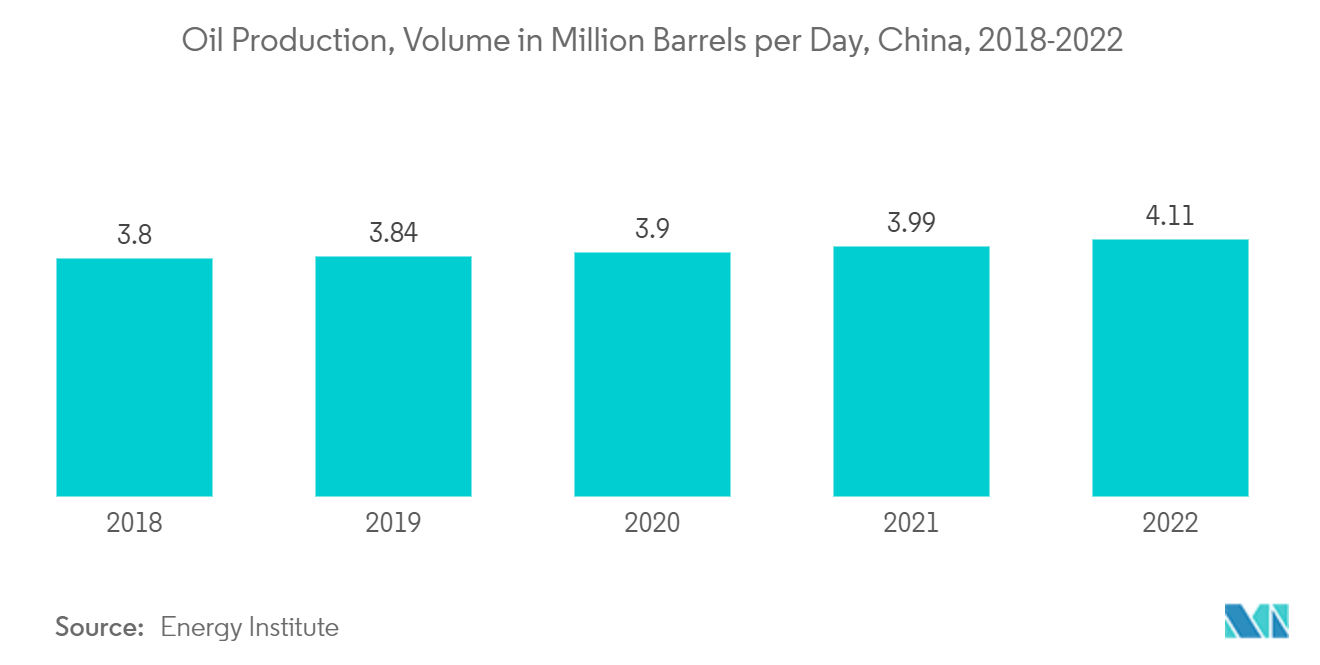Market Trends of Asia-Pacific Oilfield Chemicals Industry
Corrosion and Scale Inhibitors segment to dominate the market
- Corrosion inhibitors are used to reduce corrosion in the metallic pipes of the oil well. Inhibition is the preferred treatment for carbon steel pipes and vessels. The advantage of inhibition is that it can be used in most cases even when the process is continuing.
- Corrosion occurs due to the reaction of oxygen with metallic parts to form oxides. Corrosion inhibitors act by forming a thin barrier layer over the exposed parts. Several types of corrosion inhibitors are used in oilfields.
- These include Deha - Diethyl Hydroxyl Amine, Polyamine, Morpholine, Cyclohexylamine, and Carbon Dioxide Corrosion Inhibitors. A mixture of filming amines is used to prepare condensate line corrosion inhibitors. This can protect every stage due to the presence of both high and low vapor/liquids.
- Scale is a residue that forms on the surface of oilfield equipment as a result of the precipitation of soluble solids that become insoluble as temperature increases. This, in turn, causes metallic corrosion that affects the functioning and maintenance of equipment. This deposition increases corrosion rates, causes loss of production, and restricts flow.
- Hence, to safeguard oilfield equipment and to maintain their efficiency, it is necessary to maintain accurate conditions by adding scientifically designed chemicals that act as scale inhibitors. Chemicals, such as organic phosphates, inorganic phosphates, polymers (polyacrylates), phosphonates, and ethylenediaminetetraacetic acid (EDTA), an organic chelating agent, are some of the scaling inhibitors. Corrosion inhibitors are used to reduce corrosion in metallic pipes of oil wells. Inhibition is the preferred treatment for carbon steel pipes and vessels.
- As per Rystad, offshore projects will drive the recovery in greenfield investment, with significant demand for subsea infrastructure and drilling services in the oil and gas industry.
- For example, Petronas's Kasawari announced investment approval for the first carbon capture and storage (CCS) in Malaysia, which was followed by Thai company PTT Exploration and Productions's (PTTEP's) Lang Lebah, targeting FID in 2023 in Malaysia.
- Shell's recent investment approval for the Gumusut-Kakap-Geronggong-Jagus East (GKGJE) deep-water project – a subsea tieback development planned to start up in 2024, according to the Energy Industries Council.
- As per S&P Global Inc., New Zealand's Refining NZ said it was working to finalize terminal services agreements with customers in October to enable the conversion of its Marsden Point refinery into an import terminal in the first half of 2022.
- As per S&P Global Inc, Australia's Viva Energy welcomed the federal government's announcement of a fuel security package and, as part of this, would make a six-year commitment to maintain refining operations at Geelong through to June 2027 with a further three-year option to extend until June 2030.
- A USD 4 billion clean fuel project is being undertaken at Thailand's Sriracha refinery. The upgrade is slated to be completed in 2023 and will increase the refinery's capacity from 275,000 b/d to 400,000 b/d, boosting the yield of cleaner products. as per S&P Global Inc.
- Furthermore, new contracts for maintenance in Asia-Pacific exhibit increased investment in corrosion and scale inhibitors during the forecast period.

China to Dominate the Market
- The oil and gas industry is one of the key contributors to the Chinese economy. The oil and gas industry operates in high-temperature environments.
- Oilfield chemicals are used in drilling, production, stimulation, and enhanced oil recovery activities. Developing oil and gas reserves from shale formations requires activities such as hydraulic drilling, which encourages the use of oilfield chemicals. China has achieved many milestones in capacity and drilling techniques in shale gas exploration. This makes it one of the top shale gas suppliers around the globe.
- According to BP Statistical Review 2023, the overall oil production in the country reached 204.7 million metric tons in 2022 at a growth rate of 2.9% compared to 198.9 million metric tons produced in 2021.
- Similarly, the country's overall oil consumption has been on the rise over the past decade. For instance, in 2022, the country's oil consumption in thousands of barrels per day was 14,295 thousand barrels per day, whereas in 2021, the consumption stood at 14,893 thousand barrels per day. In addition, the consumption growth rate has been 3.6% yearly over the decade between 2012 and 22.
- Moreover, the same source cited that the country witnessed positive growth in natural gas production. For instance, in 2021, the natural gas produced was 209.2 billion cubic meters, whereas in 2022, the production increased to 221.8 billion cubic meters, which is around 6.0% growth. In addition, over the decade, production has been growing by an average of 7.1% yearly.
- The increase in the production capacities of oil and gas in the country is likely to drive the market for oilfield chemicals in the country.

